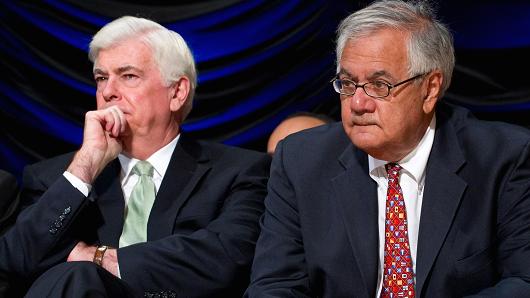A long-awaited change regarding which banks are designated as “too big to fail” finally could become reality this week.
Two years in the making, Rep. Blaine Luetkemeyer’s bill to raise the minimum asset level under which a bank is considered “systemically important” is likely to be voted on in committee Tuesday night and possibly head to the floor for a full House vote Wednesday.
Essentially, the measure is aimed at getting community and regional banks regulatory relief. The Dodd-Frank reforms that came about from the financial crisis put the level for intensified regulation at $50 billion in assets, a metric that Republicans and small-bank advocates say is too low, and which therefore places too many smaller banks under the same level of scrutiny as the Wall Street giants.
The Luetkemeyer measure strips that provision from Dodd-Frank and replaces it with “shall be deemed to have been the subject of a final determination” under the act. The level is likely to come up considerably from there, with some banking experts suggesting a number around $125 billion, though that ultimately would be determined through individual reviews.
“Assessing an institution through various factors, as opposed to asset size only, will allow for a more comprehensive assessment of risk to the overall financial system,” Tim Pawlenty, CEO of the Financial Services Roundtable industry advocacy group, said in a letter to the Financial Services Committee. The bill “advances that goal and will lead to more effective regulations while also allowing financial institutions to help grow the economy and serve both consumers and businesses better.”
Just 35 of 6,500 U.S. banks currently fit over the $50 billion tier. Dodd-Frank says those banks are subject to “enhanced supervision and prudential standards,” though regulators have discretion about how those measures are applied. Another tier, above $250 billion, applies an “advanced approach” to regulation. The top 10 U.S. banks are subject to that level.
The attempt to help smaller banks has been floating around Congress since at least 2014 but has stalled each time. With momentum building to make some common-sense alterations to Dodd-Frank — particularly in light of Donald Trump’s victory in the presidential election — the time could be right for the bill to pass.
Limits like the $50 billion bar for systemic danger designation “provide an incentive for banks to artificially stay below a threshold or, once they have crossed it, to grow even larger to spread out the costs associated with ascending to a higher regulatory tier,” the Bipartisan Policy Center said in a recent analysis. “Most of the thresholds were chosen arbitrarily; the $50 billion threshold was defined by statute, without a formal analysis.”
No less an authority than former Democratic Rep. Barney Frank, who co-authored the post-financial crisis banking rules, said recently the “systemically important” designation was a mistake and should be raised.
It’s still not clear whether the Senate will take up the legislation before Congress adjourns, but the momentum appears in the bill’s favor.
The move comes amid expectations that Trump will take a hammer to much of the regulatory framework set out during the Obama administration. The Republican pledged during the campaign to repeal Dodd-Frank, though the party platform also included a provision to reinstitute the Glass-Steagall Act that separated commercial
source”cnbc”





